All Exams >
MCAT >
Physics for MCAT >
All Questions
All questions of Translational Motion and Calculations for MCAT Exam
An object is dropped from the top of the Empire State Building. Which of the following statements best describes the motion of the object as it experiences air resistance during its downward fall?- a)The speed will increase at a constant rate for its fall.
- b)The speed will decrease at a constant rate for its fall.
- c)Its speed remains constant for the fall.
- d)Its acceleration will decrease until the object starts moving with a constant speed.
Correct answer is option 'D'. Can you explain this answer?
An object is dropped from the top of the Empire State Building. Which of the following statements best describes the motion of the object as it experiences air resistance during its downward fall?
a)
The speed will increase at a constant rate for its fall.
b)
The speed will decrease at a constant rate for its fall.
c)
Its speed remains constant for the fall.
d)
Its acceleration will decrease until the object starts moving with a constant speed.
|
|
Amelia Taylor answered |
Understanding the Motion of a Falling Object with Air Resistance
When an object is dropped from a great height, such as the Empire State Building, its motion is influenced significantly by air resistance. Here's a detailed breakdown of what happens during its fall.
Initial Free Fall
- When the object is initially dropped, it accelerates downward due to gravity, which is approximately 9.81 m/s².
- During this phase, the object’s speed increases rapidly as it falls.
Effect of Air Resistance
- As the object gains speed, it encounters air resistance, which acts in the opposite direction to its motion.
- This resistance increases with the speed of the object; hence, the faster the object falls, the greater the air resistance acting against it.
Transition to Terminal Velocity
- Eventually, the force of air resistance grows enough to balance the gravitational force acting on the object.
- At this point, the object stops accelerating and continues to fall at a constant speed known as terminal velocity.
Acceleration Changes
- Initially, the object has a constant acceleration due to gravity.
- As air resistance increases, the net force acting on the object decreases, leading to a reduction in acceleration.
- The object’s acceleration decreases until it reaches zero at terminal velocity, where it moves at a constant speed.
Conclusion
- Therefore, option 'D' is correct: "Its acceleration will decrease until the object starts moving with a constant speed."
- This describes the transition from free fall to terminal velocity, illustrating how air resistance impacts the motion of the falling object.
When an object is dropped from a great height, such as the Empire State Building, its motion is influenced significantly by air resistance. Here's a detailed breakdown of what happens during its fall.
Initial Free Fall
- When the object is initially dropped, it accelerates downward due to gravity, which is approximately 9.81 m/s².
- During this phase, the object’s speed increases rapidly as it falls.
Effect of Air Resistance
- As the object gains speed, it encounters air resistance, which acts in the opposite direction to its motion.
- This resistance increases with the speed of the object; hence, the faster the object falls, the greater the air resistance acting against it.
Transition to Terminal Velocity
- Eventually, the force of air resistance grows enough to balance the gravitational force acting on the object.
- At this point, the object stops accelerating and continues to fall at a constant speed known as terminal velocity.
Acceleration Changes
- Initially, the object has a constant acceleration due to gravity.
- As air resistance increases, the net force acting on the object decreases, leading to a reduction in acceleration.
- The object’s acceleration decreases until it reaches zero at terminal velocity, where it moves at a constant speed.
Conclusion
- Therefore, option 'D' is correct: "Its acceleration will decrease until the object starts moving with a constant speed."
- This describes the transition from free fall to terminal velocity, illustrating how air resistance impacts the motion of the falling object.
To reach the orbital altitude of Earth, a space shuttle must accelerate from zero to 8,000 meters per second (~18,000 miles per hour) in eight and a half minutes. What would the minimum average acceleration of the shuttle have to be in order to achieve this?- a)8 m/s2
- b)15 m/s2
- c)50 m/s2
- d)30 m/s2
Correct answer is option 'B'. Can you explain this answer?
To reach the orbital altitude of Earth, a space shuttle must accelerate from zero to 8,000 meters per second (~18,000 miles per hour) in eight and a half minutes. What would the minimum average acceleration of the shuttle have to be in order to achieve this?
a)
8 m/s2
b)
15 m/s2
c)
50 m/s2
d)
30 m/s2
|
|
Wyatt Gonzales answered |
Minimum Average Acceleration to Reach Orbital Altitude of Earth
To determine the minimum average acceleration required for a space shuttle to reach the orbital altitude of Earth, we need to use the given information of the shuttle's final velocity and the time it takes to reach that velocity.
Given:
Final velocity (v) = 8,000 m/s
Time (t) = 8.5 minutes = 8.5 * 60 seconds = 510 seconds
To find the minimum average acceleration, we can use the following equation of motion:
v = u + at
Where:
v = final velocity
u = initial velocity (which is 0 in this case)
a = acceleration
t = time
Step 1: Calculate the initial velocity (u)
Since the initial velocity (u) is given as 0, we can substitute this value into the equation:
v = u + at
8000 = 0 + a * 510
Step 2: Rearrange the equation and solve for acceleration (a)
8000 = a * 510
a = 8000 / 510
a ≈ 15.69 m/s^2
Since the question asks for the minimum average acceleration, we round the value to the nearest whole number, which is 16 m/s^2.
Answer: The minimum average acceleration required for the space shuttle to reach the orbital altitude of Earth is approximately 16 m/s^2. Therefore, the correct answer is option 'B' - 15 m/s^2.
To determine the minimum average acceleration required for a space shuttle to reach the orbital altitude of Earth, we need to use the given information of the shuttle's final velocity and the time it takes to reach that velocity.
Given:
Final velocity (v) = 8,000 m/s
Time (t) = 8.5 minutes = 8.5 * 60 seconds = 510 seconds
To find the minimum average acceleration, we can use the following equation of motion:
v = u + at
Where:
v = final velocity
u = initial velocity (which is 0 in this case)
a = acceleration
t = time
Step 1: Calculate the initial velocity (u)
Since the initial velocity (u) is given as 0, we can substitute this value into the equation:
v = u + at
8000 = 0 + a * 510
Step 2: Rearrange the equation and solve for acceleration (a)
8000 = a * 510
a = 8000 / 510
a ≈ 15.69 m/s^2
Since the question asks for the minimum average acceleration, we round the value to the nearest whole number, which is 16 m/s^2.
Answer: The minimum average acceleration required for the space shuttle to reach the orbital altitude of Earth is approximately 16 m/s^2. Therefore, the correct answer is option 'B' - 15 m/s^2.
A Boeing 747 aircraft has a landing speed of 72 m/s, and upon landing it is able to come to a stop in 2,000 m. Assuming constant deceleration, how long would it take for a Boeing 747 to come to a full stop?- a)14 seconds
- b)28 seconds
- c)56 seconds
- d)72 seconds
Correct answer is option 'C'. Can you explain this answer?
A Boeing 747 aircraft has a landing speed of 72 m/s, and upon landing it is able to come to a stop in 2,000 m. Assuming constant deceleration, how long would it take for a Boeing 747 to come to a full stop?
a)
14 seconds
b)
28 seconds
c)
56 seconds
d)
72 seconds
|
|
Henry Phillips answered |
Given data:
- Landing speed = 72 m/s
- Stopping distance = 2000 m
Calculating deceleration:
- Initial velocity (u) = 72 m/s
- Final velocity (v) = 0 m/s
- Distance (s) = 2000 m
- Using the equation of motion: v^2 = u^2 + 2as
- 0 = (72)^2 + 2*a*2000
- Solving for acceleration (a): a = -72^2 / (2*2000) = -1.296 m/s^2
Calculating time taken to stop:
- Using the equation of motion: v = u + at
- 0 = 72 + (-1.296)*t
- Solving for time (t): t = 72 / 1.296 ≈ 55.56 seconds
Therefore, it would take approximately 56 seconds for a Boeing 747 to come to a full stop after landing. So, the correct answer is option 'C' - 56 seconds.
- Landing speed = 72 m/s
- Stopping distance = 2000 m
Calculating deceleration:
- Initial velocity (u) = 72 m/s
- Final velocity (v) = 0 m/s
- Distance (s) = 2000 m
- Using the equation of motion: v^2 = u^2 + 2as
- 0 = (72)^2 + 2*a*2000
- Solving for acceleration (a): a = -72^2 / (2*2000) = -1.296 m/s^2
Calculating time taken to stop:
- Using the equation of motion: v = u + at
- 0 = 72 + (-1.296)*t
- Solving for time (t): t = 72 / 1.296 ≈ 55.56 seconds
Therefore, it would take approximately 56 seconds for a Boeing 747 to come to a full stop after landing. So, the correct answer is option 'C' - 56 seconds.
A car travels from point A to B in 3 hours and returns back to point A in 5 hours. Points A and B are 150 miles apart along a straight highway. Which of the following statements most accurately describes the motion of the car?- a)The car travels at 50 mph for the first half and 30 mph for the second half.
- b)The average speed is 37.5 miles per hour.
- c)The total displacement of the trip is 300 miles.
- d)The average velocity is 40 miles per hour.
Correct answer is option 'B'. Can you explain this answer?
A car travels from point A to B in 3 hours and returns back to point A in 5 hours. Points A and B are 150 miles apart along a straight highway. Which of the following statements most accurately describes the motion of the car?
a)
The car travels at 50 mph for the first half and 30 mph for the second half.
b)
The average speed is 37.5 miles per hour.
c)
The total displacement of the trip is 300 miles.
d)
The average velocity is 40 miles per hour.
|
|
Mia Anderson answered |
Statement: The average speed is 37.5 miles per hour.
To determine the accuracy of this statement, let's examine the given information and calculate the average speed of the car.
Given information:
- Distance from point A to B: 150 miles
- Time taken to travel from A to B: 3 hours
- Time taken to return from B to A: 5 hours
Calculating average speed:
Average speed is calculated by dividing the total distance traveled by the total time taken.
Total distance traveled = Distance from A to B + Distance from B to A = 150 miles + 150 miles = 300 miles
Total time taken = Time taken from A to B + Time taken from B to A = 3 hours + 5 hours = 8 hours
Average speed = Total distance traveled / Total time taken = 300 miles / 8 hours = 37.5 miles per hour
Therefore, the statement that the average speed is 37.5 miles per hour is accurate.
Explanation:
The average speed of an object is defined as the total distance traveled divided by the total time taken. In this case, the car traveled a total distance of 300 miles (150 miles from A to B and 150 miles from B to A) in a total time of 8 hours (3 hours from A to B and 5 hours from B to A). Dividing the total distance by the total time gives us an average speed of 37.5 miles per hour.
It is important to note that average speed does not take into account the variations in speed during different parts of the journey. The car could have traveled at different speeds during different segments of the trip, but the average speed provides a single value that represents the overall speed of the car.
Therefore, option B is the most accurate statement as it correctly describes the average speed of the car as 37.5 miles per hour.
To determine the accuracy of this statement, let's examine the given information and calculate the average speed of the car.
Given information:
- Distance from point A to B: 150 miles
- Time taken to travel from A to B: 3 hours
- Time taken to return from B to A: 5 hours
Calculating average speed:
Average speed is calculated by dividing the total distance traveled by the total time taken.
Total distance traveled = Distance from A to B + Distance from B to A = 150 miles + 150 miles = 300 miles
Total time taken = Time taken from A to B + Time taken from B to A = 3 hours + 5 hours = 8 hours
Average speed = Total distance traveled / Total time taken = 300 miles / 8 hours = 37.5 miles per hour
Therefore, the statement that the average speed is 37.5 miles per hour is accurate.
Explanation:
The average speed of an object is defined as the total distance traveled divided by the total time taken. In this case, the car traveled a total distance of 300 miles (150 miles from A to B and 150 miles from B to A) in a total time of 8 hours (3 hours from A to B and 5 hours from B to A). Dividing the total distance by the total time gives us an average speed of 37.5 miles per hour.
It is important to note that average speed does not take into account the variations in speed during different parts of the journey. The car could have traveled at different speeds during different segments of the trip, but the average speed provides a single value that represents the overall speed of the car.
Therefore, option B is the most accurate statement as it correctly describes the average speed of the car as 37.5 miles per hour.
A Ferrari Enzo is able to reach a speed of 134 miles per hour (60 meter/sec) from 0mph in 11 seconds. Assuming constant acceleration, how far would the Enzo travel in this amount of time?- a)5.45 kilometers
- b)330 meters
- c)400 meters
- d)660 meters
Correct answer is option 'B'. Can you explain this answer?
A Ferrari Enzo is able to reach a speed of 134 miles per hour (60 meter/sec) from 0mph in 11 seconds. Assuming constant acceleration, how far would the Enzo travel in this amount of time?
a)
5.45 kilometers
b)
330 meters
c)
400 meters
d)
660 meters

|
Orion Classes answered |
To find displacement with constant acceleration, we can use the formula: d = Δt (va)
Our Δt should simply be 11 secs
Our va is simply the average velocity, which we can calculate using: va = 1/2(vf + vi) or va = ½ (0+60) which gives us va = 30 m/s
Using our initial formula, d = Δt (va), d = 11 sec x 30 m/s or d = 330 m
Top fuel dragster cars can accelerate from rest down a quarter mile track (400 meters) in under 4 seconds. Assuming constant acceleration, what would the acceleration of a dragster be if it sped down a track in exactly 4 seconds?- a)75 m/s2
- b)100 m/s2
- c)50 m/s 2
- d)25 m/s2
Correct answer is option 'C'. Can you explain this answer?
Top fuel dragster cars can accelerate from rest down a quarter mile track (400 meters) in under 4 seconds. Assuming constant acceleration, what would the acceleration of a dragster be if it sped down a track in exactly 4 seconds?
a)
75 m/s2
b)
100 m/s2
c)
50 m/s 2
d)
25 m/s2
|
|
Liam Johnson answered |
Explanation:
Acceleration can be calculated using the equation:
\[a = \frac{v_f - v_i}{t}\]
Where:
- \(a\) = acceleration
- \(v_f\) = final velocity
- \(v_i\) = initial velocity
- \(t\) = time
Given that the dragster accelerates from rest, the initial velocity is 0 m/s. The final velocity can be calculated using the equation for distance traveled with constant acceleration:
\[d = \frac{1}{2} a t^2\]
Calculations:
- Distance, \(d\) = 400 meters
- Time, \(t\) = 4 seconds
Using the distance equation:
\[400 = \frac{1}{2} a (4)^2\]
\[400 = 8a\]
\[a = \frac{400}{8} = 50 \, m/s^2\]
Therefore, the acceleration of the dragster would be 50 m/s^2 if it sped down a track in exactly 4 seconds.
This acceleration is the correct answer as option 'C'.
Acceleration can be calculated using the equation:
\[a = \frac{v_f - v_i}{t}\]
Where:
- \(a\) = acceleration
- \(v_f\) = final velocity
- \(v_i\) = initial velocity
- \(t\) = time
Given that the dragster accelerates from rest, the initial velocity is 0 m/s. The final velocity can be calculated using the equation for distance traveled with constant acceleration:
\[d = \frac{1}{2} a t^2\]
Calculations:
- Distance, \(d\) = 400 meters
- Time, \(t\) = 4 seconds
Using the distance equation:
\[400 = \frac{1}{2} a (4)^2\]
\[400 = 8a\]
\[a = \frac{400}{8} = 50 \, m/s^2\]
Therefore, the acceleration of the dragster would be 50 m/s^2 if it sped down a track in exactly 4 seconds.
This acceleration is the correct answer as option 'C'.
Aroldis Chapman holds the world record for fastest baseball pitch at 105.1 mph (169 km/h). The distance from the pitcher’s mound to home plate is approximately 60 feet (~18 meters). Assuming constant velocity, how much time would a batter have to react to Chapman’s world record pitch?- a)0.1 seconds
- b)1 second
- c)0.4 seconds
- d)0.75 seconds
Correct answer is option 'C'. Can you explain this answer?
Aroldis Chapman holds the world record for fastest baseball pitch at 105.1 mph (169 km/h). The distance from the pitcher’s mound to home plate is approximately 60 feet (~18 meters). Assuming constant velocity, how much time would a batter have to react to Chapman’s world record pitch?
a)
0.1 seconds
b)
1 second
c)
0.4 seconds
d)
0.75 seconds
|
|
Wyatt Gonzales answered |
To home plate in Major League Baseball is 60 feet 6 inches (18.4 meters).
A police car accelerates quickly to 60 meters per second in order to pursue a minivan that is recklessly speeding along the highway at 45 meters per second. How long will it take the police car to catch up if the minivan is 600 meters ahead of the police car at the beginning of the chase?- a)10 seconds
- b)15 seconds
- c)40 seconds
- d)50 seconds
Correct answer is option 'C'. Can you explain this answer?
A police car accelerates quickly to 60 meters per second in order to pursue a minivan that is recklessly speeding along the highway at 45 meters per second. How long will it take the police car to catch up if the minivan is 600 meters ahead of the police car at the beginning of the chase?
a)
10 seconds
b)
15 seconds
c)
40 seconds
d)
50 seconds
|
|
Naomi Reed answered |
Understanding the Problem:
First, we need to understand the situation presented in the problem. A police car is chasing a minivan that is 600 meters ahead and traveling at a speed of 45 m/s. The police car accelerates quickly to 60 m/s in order to catch up with the minivan.
Calculating the Relative Speed:
In order to catch up with the minivan, the police car needs to cover the initial 600 meters between them. The relative speed between the police car and the minivan is 60 m/s - 45 m/s = 15 m/s.
Calculating the Time to Catch Up:
To calculate the time it will take for the police car to catch up with the minivan, we can use the formula:
\[ \text{Time} = \frac{\text{Distance}}{\text{Speed}} \]
\[ \text{Time} = \frac{600 \text{ meters}}{15 \text{ m/s}} \]
\[ \text{Time} = 40 \text{ seconds} \]
Therefore, it will take the police car 40 seconds to catch up with the minivan that is 600 meters ahead. So, the correct answer is option c) 40 seconds.
First, we need to understand the situation presented in the problem. A police car is chasing a minivan that is 600 meters ahead and traveling at a speed of 45 m/s. The police car accelerates quickly to 60 m/s in order to catch up with the minivan.
Calculating the Relative Speed:
In order to catch up with the minivan, the police car needs to cover the initial 600 meters between them. The relative speed between the police car and the minivan is 60 m/s - 45 m/s = 15 m/s.
Calculating the Time to Catch Up:
To calculate the time it will take for the police car to catch up with the minivan, we can use the formula:
\[ \text{Time} = \frac{\text{Distance}}{\text{Speed}} \]
\[ \text{Time} = \frac{600 \text{ meters}}{15 \text{ m/s}} \]
\[ \text{Time} = 40 \text{ seconds} \]
Therefore, it will take the police car 40 seconds to catch up with the minivan that is 600 meters ahead. So, the correct answer is option c) 40 seconds.
An ambulance is currently traveling at 15m/s, and is accelerating with a constant acceleration of 5 m/s2. The ambulance is attempting to pass a car which is moving at a constant velocity of 30m/s. How far must the ambulance travel until it matches the car’s velocity?- a)67.5 km
- b)67.5 m
- c)90 m
- d)45 m
Correct answer is option 'B'. Can you explain this answer?
An ambulance is currently traveling at 15m/s, and is accelerating with a constant acceleration of 5 m/s2. The ambulance is attempting to pass a car which is moving at a constant velocity of 30m/s. How far must the ambulance travel until it matches the car’s velocity?
a)
67.5 km
b)
67.5 m
c)
90 m
d)
45 m

|
Orion Classes answered |
To find displacement with constant acceleration, we can use the formula: d= Δt (va)
Our Δt should simply be the time it takes to go from 15 m/s to 30 m/s at an acceleration of 5 m/s2: Δv = aΔt or 15 = 5Δt, which gives us Δt = 3.
Our va is simply the average velocity, which we can calculate using: va = 1/2(vf + vi) or va = 1/2 (30+15) which gives us va = 22.5 m/s
Using our initial formula, d = Δt (va), d = 3 sec x 22.5 m/s or d = 67.5m
In 1997, the Thrust SSC, a turbofan powered vehicle, achieved the land speed world record of 760.34 mph (1,223.65 km/h) and became the first car to break the sound barrier. If it took 1 minute for the Thrust SSC to reach its top speed, what was the average acceleration during that time?- a)3.53 m/s2
- b)5.67 m/s2
- c)7.88 m/s2
- d)9.82 m/s2
Correct answer is option 'B'. Can you explain this answer?
In 1997, the Thrust SSC, a turbofan powered vehicle, achieved the land speed world record of 760.34 mph (1,223.65 km/h) and became the first car to break the sound barrier. If it took 1 minute for the Thrust SSC to reach its top speed, what was the average acceleration during that time?
a)
3.53 m/s2
b)
5.67 m/s2
c)
7.88 m/s2
d)
9.82 m/s2
|
|
Owen Morris answered |
Calculating Average Acceleration
To calculate the average acceleration of the Thrust SSC during the 1-minute acceleration period, we can use the formula:
\[a = \dfrac{v_f - v_i}{t}\]
- \(a\) is the average acceleration
- \(v_f\) is the final velocity (760.34 mph)
- \(v_i\) is the initial velocity (0 mph)
- \(t\) is the time taken to reach the final velocity (1 minute or 60 seconds)
Converting Units
Before plugging the values into the formula, we need to convert the final velocity from mph to m/s:
\[760.34 \text{ mph} \times \dfrac{1609.344 \text{ m}}{1 \text{ mile}} \times \dfrac{1 \text{ hour}}{3600 \text{ seconds}} = 340.29 \text{ m/s}\]
Calculating Average Acceleration
Now, we can substitute the values into the formula:
\[a = \dfrac{340.29 \text{ m/s} - 0 \text{ m/s}}{60 \text{ s}} = \dfrac{340.29 \text{ m/s}}{60 \text{ s}} = 5.67 \text{ m/s}^2\]
Therefore, the average acceleration of the Thrust SSC during the 1-minute acceleration period was 5.67 m/s².
To calculate the average acceleration of the Thrust SSC during the 1-minute acceleration period, we can use the formula:
\[a = \dfrac{v_f - v_i}{t}\]
- \(a\) is the average acceleration
- \(v_f\) is the final velocity (760.34 mph)
- \(v_i\) is the initial velocity (0 mph)
- \(t\) is the time taken to reach the final velocity (1 minute or 60 seconds)
Converting Units
Before plugging the values into the formula, we need to convert the final velocity from mph to m/s:
\[760.34 \text{ mph} \times \dfrac{1609.344 \text{ m}}{1 \text{ mile}} \times \dfrac{1 \text{ hour}}{3600 \text{ seconds}} = 340.29 \text{ m/s}\]
Calculating Average Acceleration
Now, we can substitute the values into the formula:
\[a = \dfrac{340.29 \text{ m/s} - 0 \text{ m/s}}{60 \text{ s}} = \dfrac{340.29 \text{ m/s}}{60 \text{ s}} = 5.67 \text{ m/s}^2\]
Therefore, the average acceleration of the Thrust SSC during the 1-minute acceleration period was 5.67 m/s².
Which of the following statements best represents an example of instantaneous velocity?- a)The car traveled a distance of 100 miles in the second hour of travel to Saskatchewan.
- b)The projectile was traveling upward at 50 meters per second ten seconds after its launch from the cannon.
- c)The new aircraft built by Boeing has a maximum cruising speed of 400 miles per hour.
- d)The train will take 5 hours in total to reach its final destination of Boston traveling at 15 miles per hour.
Correct answer is option 'B'. Can you explain this answer?
Which of the following statements best represents an example of instantaneous velocity?
a)
The car traveled a distance of 100 miles in the second hour of travel to Saskatchewan.
b)
The projectile was traveling upward at 50 meters per second ten seconds after its launch from the cannon.
c)
The new aircraft built by Boeing has a maximum cruising speed of 400 miles per hour.
d)
The train will take 5 hours in total to reach its final destination of Boston traveling at 15 miles per hour.

|
Orion Classes answered |
Instantaneous velocity represents the velocity at a specific instant in time.
By saying the aircraft has a maximum cruising speed of 400 miles per hour, it is still only a potential value to attain. When or whether it actually reaches this velocity is unknown.
Knowing the velocity and time will often aid in figuring out the displacement, given a constant velocity or average velocity, like traveling 15 mph for 5 hours.
Knowing the distance and time will often aid in figuring out an average velocity, like traveling 100 miles in an hour.
If the projectile was traveling upward at 50 m/s at 10 sec after its launch, then we know its instantaneous velocity.
The velocity of a toy car is plotted on the following graph. What is the total distance travelled by the toy?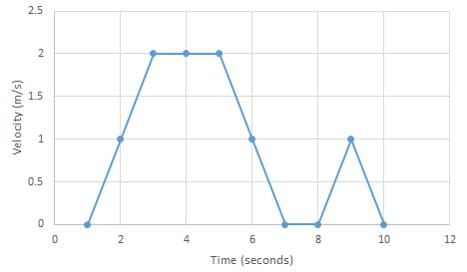
- a)20 m
- b)5 m
- c)9 m
- d)11 m
Correct answer is option 'C'. Can you explain this answer?
The velocity of a toy car is plotted on the following graph. What is the total distance travelled by the toy?

a)
20 m
b)
5 m
c)
9 m
d)
11 m

|
Orion Classes answered |
To find displacement on a velocity vs. time graph, we simply can calculate the area under the curve.
To calculate the area, we can split the graph into geometric shapes by drawing vertical lines at times 3, 5, and 9. This gives us 4 right triangles and one rectangle.
The two larger triangles have equal areas of ½ (2x2) which those two combined gives us an area of 4. The rectangle has an area (2x2) giving us an area of 4. Finally the last two smaller triangles have an area of ½ (1x1) giving us a combined area of 1.
Adding up these areas then, we have 4+4+1, or 9m total.
At time t = 1 min the car is traveling at a velocity of 20 meters per second, and at time t = 2 min the car reaches a velocity of 40 meters per second. Which statement best describes the car’s motion during this time interval?- a)The car’s average acceleration is 0.33 m/s2
- b)The car’s average speed is the same as the car’s average velocity.
- c)The car’s average velocity is 30 m/s, assuming a straight path of travel.
- d)The car’s velocity never drops below 20 m/s and never surpasses 40 m/s.
Correct answer is option 'A'. Can you explain this answer?
At time t = 1 min the car is traveling at a velocity of 20 meters per second, and at time t = 2 min the car reaches a velocity of 40 meters per second. Which statement best describes the car’s motion during this time interval?
a)
The car’s average acceleration is 0.33 m/s2
b)
The car’s average speed is the same as the car’s average velocity.
c)
The car’s average velocity is 30 m/s, assuming a straight path of travel.
d)
The car’s velocity never drops below 20 m/s and never surpasses 40 m/s.

|
Orion Classes answered |
Average velocity is change in displacement over time, but if the car were traveling at a constant acceleration then the average velocity would be 30 m/s.
Average speed is distance over time. If we were to assume travel in a straight line in one direction only, then they would be the same.
The instantaneous velocity at 1 minute is 20 m/s and at 2 minutes is 40 m/s. In the time interval, velocity could take on any value, positive or negative.
The average acceleration is change in velocity over time. 20 m/s divided by 60 sec is equal to 0.33 m/s2 squared.
Based on the displacement-time graph below, which of the following statements accurately describes the car’s motion?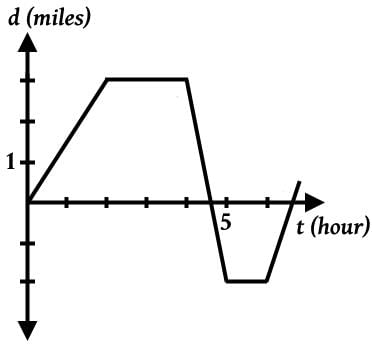
- a)The speed at 4.5 hours is greater than the speed at 1 hour.
- b)The car has the greatest velocity from 2.0 to 4.0 hours.
- c)The car comes to a halt 3 times during the trip.
- d)The car has the greatest acceleration from 4 to 5 hours.
Correct answer is option 'A'. Can you explain this answer?
Based on the displacement-time graph below, which of the following statements accurately describes the car’s motion?

a)
The speed at 4.5 hours is greater than the speed at 1 hour.
b)
The car has the greatest velocity from 2.0 to 4.0 hours.
c)
The car comes to a halt 3 times during the trip.
d)
The car has the greatest acceleration from 4 to 5 hours.

|
Orion Classes answered |
The slope of the tangent represents velocity, and the greater the absolute value of the slope, the greater the velocity. From 4 to 5 hours, although the slope is negative, the car travels with the greatest velocity.
The car comes to halt when the graph is horizontal or forms a crest or trough. The car stops twice during the trip during 2 to 4 hours and then 5 to 6 hours.
The car has the greatest acceleration when velocity changes the most. Any straight line portion represents constant velocity. The points of greatest acceleration are where the graph forms angles: 2, 4, 5, and 6 hours.
The speed can be found by taking the absolute value of the slope of the tangent. The slope of the tangent at 4.5 hours, while it is negative, is greater than at 1 hour.
According to the velocity-time graph below, how many times does the particle attain zero acceleration during the entire path?
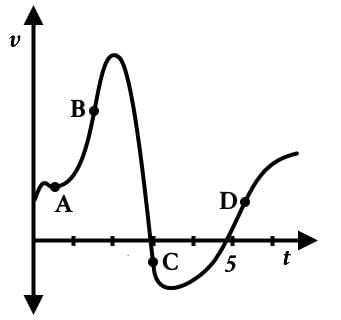
- a)2
- b)3
- c)4
- d)5
Correct answer is option 'C'. Can you explain this answer?
According to the velocity-time graph below, how many times does the particle attain zero acceleration during the entire path?


a)
2
b)
3
c)
4
d)
5

|
Orion Classes answered |
On a velocity-time graph, there is zero acceleration whenever the particle goes from a positive to negative acceleration or vice versa.
Positive acceleration is indicated by tangents with positive slope like point B, and negative acceleration by tangents with negative slope like point C, so between point B and C at the maximum, there is zero acceleration.
Between C and D, there is a global minimum, which indicates zero acceleration.
Look for local minima and maxima, and there is a maximum before A and a minimum at A, so there are 4 instances.
According to the velocity-time graph below, which of the following best characterizes the magnitude of acceleration and displacement at point B as compared with point C?
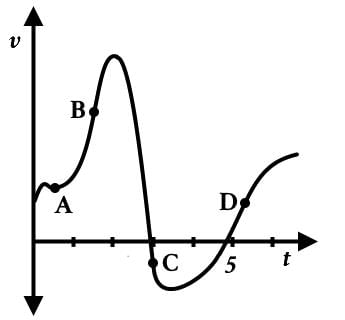
- a)Acceleration is greater in magnitude at point B, and displacement is lesser at point B
- b)Acceleration is greater in magnitude at point C, and displacement is greater at point B
- c)Acceleration is lesser in magnitude at point C, and displacement is lesser at point C
- d)Acceleration is lesser in magnitude at point B, and displacement is greater at point C
Correct answer is option 'D'. Can you explain this answer?
According to the velocity-time graph below, which of the following best characterizes the magnitude of acceleration and displacement at point B as compared with point C?


a)
Acceleration is greater in magnitude at point B, and displacement is lesser at point B
b)
Acceleration is greater in magnitude at point C, and displacement is greater at point B
c)
Acceleration is lesser in magnitude at point C, and displacement is lesser at point C
d)
Acceleration is lesser in magnitude at point B, and displacement is greater at point C

|
Orion Classes answered |
The magnitude of acceleration can be determined by looking at the slope of the tangent at a given point.
At point B, the tangent has a positive slope, and at point C, the tangent has a negative slope. While the slope is negative at point C, the tangent is steeper, so C has a greater magnitude of acceleration or B a lesser magnitude of acceleration.
From the starting point, for the first 3 minutes, the car is traveling away in the positive direction. For a very brief period after 3 minutes, where the graph dips below the x-axis, the car travels back in the negative direction.
Displacement is greater at point C because the car only starts to travel back in the negative direction, which does not make up for the distance traveled after point B. Acceleration is lesser in magnitude at point B, and displacement is greater at point C.
Which of the following figures below represents an object that is moving at a constant velocity?- a)
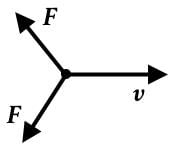
- b)
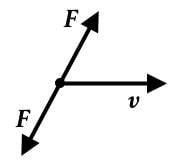
- c)

- d)
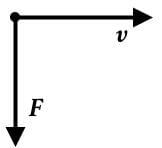
Correct answer is option 'B'. Can you explain this answer?
Which of the following figures below represents an object that is moving at a constant velocity?
a)

b)

c)

d)


|
Orion Classes answered |
Moving at a constant velocity means there is no acceleration or no unbalanced forces.
Look for a set of forces that are balanced, equal but opposite, so any diagrams with only one force vector can be eliminated:
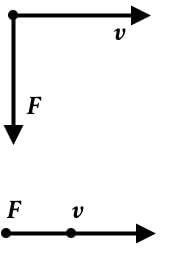
In the diagram with the forces at 120 to each other, there is an unbalanced force to the left and would slow the object down.

The two forces must be at 180° to each other in order to balance out, but the forces can be at any angle to the velocity vector.
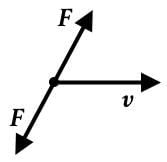
Which of the following is a true statement concerning speed, velocity, and acceleration?- a)If the displacement of an object is zero, the speed must be zero
- b)Speed is a vector quantity representing magnitude and direction
- c)An object cannot accelerate if it is moving at a constant speed
- d)An increase in speed must mean the object experiences acceleration
Correct answer is option 'D'. Can you explain this answer?
Which of the following is a true statement concerning speed, velocity, and acceleration?
a)
If the displacement of an object is zero, the speed must be zero
b)
Speed is a vector quantity representing magnitude and direction
c)
An object cannot accelerate if it is moving at a constant speed
d)
An increase in speed must mean the object experiences acceleration

|
Orion Classes answered |
The vector quantity representing magnitude and direction is velocity, not speed
Because speed is not a vector quantity, constant speed cannot tell us direction of an object. Therefore you can move at constant speed but still accelerate by changing direction.
Displacement of an object could equal zero simply by moving in a circle. If your initial and final positions are the same, your displacement is zero but your speed is not.
An object can only experience an increase in speed if it is accelerated.
Based on the velocity-time graph below, which of the following statements best characterizes the car’s motion?
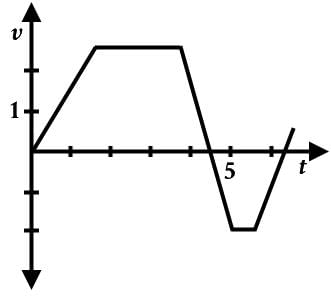
- a)The velocity changes the slowest during the first 1.5 minutes of the trip.
- b)The greatest displacement occurs between 4 and 5 minutes.
- c)The car has zero instantaneous velocity exactly 3 times during the trip.
- d)The car changes direction 4 times during its trip.
Correct answer is option 'C'. Can you explain this answer?
Based on the velocity-time graph below, which of the following statements best characterizes the car’s motion?


a)
The velocity changes the slowest during the first 1.5 minutes of the trip.
b)
The greatest displacement occurs between 4 and 5 minutes.
c)
The car has zero instantaneous velocity exactly 3 times during the trip.
d)
The car changes direction 4 times during its trip.

|
Orion Classes answered |
Positive velocity is travel in one direction and negative velocity is travel in the other direction. According to the graph, the direction changes at 4.5 and 6.25 minutes.
The area under the curve is displacement, and from 4 to 5 minutes the area is on both sides of the x-axis, which cancels each other out. The area with the greatest displacement would be from 1.5 to 3.5 minutes.
The slope represents the change in velocity or acceleration. Where the graph is horizontally flat or forms a crest or trough, the slope is zero. From 1.5 to 3.5 minutes, the velocity does not change.
When the graph crosses the x-axis, the velocity is zero. The graph crosses the x-axis at 3 points, so the car has zero instantaneous velocity 3 times.
Using our initial formula, d = Δt (va), d = 11 sec x 30 m/s or d = 330 m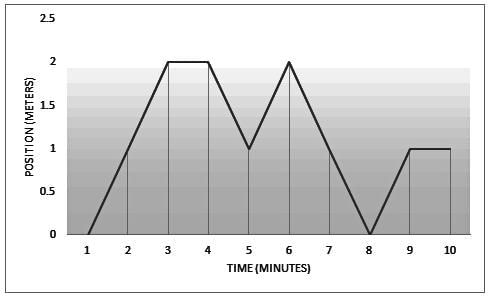
- a)0 m/s2
- b)-2 m/s2
- c)2 m/s2
- d)-4 m/s2
Correct answer is option 'A'. Can you explain this answer?
Using our initial formula, d = Δt (va), d = 11 sec x 30 m/s or d = 330 m

a)
0 m/s2
b)
-2 m/s2
c)
2 m/s2
d)
-4 m/s2

|
Orion Classes answered |
Remember that acceleration is the measure of a change in velocity [(m/s)/s] over time, while velocity is the change of displacement over time. (m/s)
Since this graph is of displacement over time, it only measures velocity.
Since the velocity (slope) is constant from minute 6 to minute 8, that means there is no change in velocity, meaning there is no acceleration. If the object has no acceleration, then the acceleration is 0.
Chapter doubts & questions for Translational Motion and Calculations - Physics for MCAT 2025 is part of MCAT exam preparation. The chapters have been prepared according to the MCAT exam syllabus. The Chapter doubts & questions, notes, tests & MCQs are made for MCAT 2025 Exam. Find important definitions, questions, notes, meanings, examples, exercises, MCQs and online tests here.
Chapter doubts & questions of Translational Motion and Calculations - Physics for MCAT in English & Hindi are available as part of MCAT exam.
Download more important topics, notes, lectures and mock test series for MCAT Exam by signing up for free.
Physics for MCAT
158 videos|21 docs|21 tests
|

Contact Support
Our team is online on weekdays between 10 AM - 7 PM
Typical reply within 3 hours
|
Free Exam Preparation
at your Fingertips!
Access Free Study Material - Test Series, Structured Courses, Free Videos & Study Notes and Prepare for Your Exam With Ease

 Join the 10M+ students on EduRev
Join the 10M+ students on EduRev
|

|
Create your account for free
OR
Forgot Password
OR
Signup to see your scores
go up within 7 days!
Access 1000+ FREE Docs, Videos and Tests
Takes less than 10 seconds to signup









